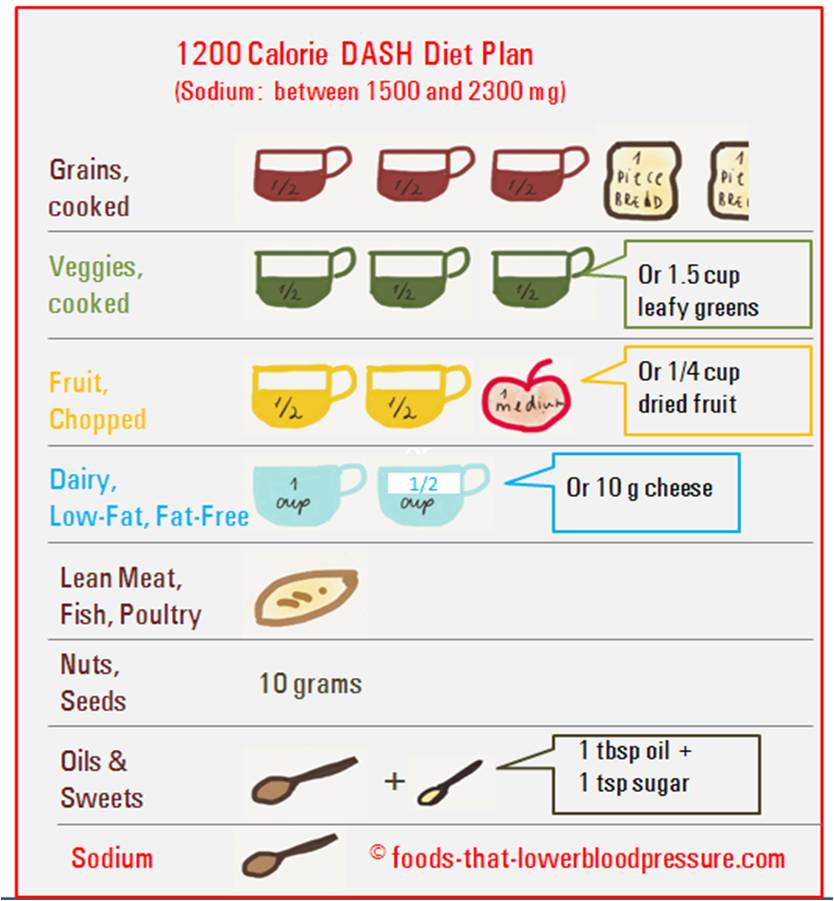DASH to lower your Blood Pressure!

DASH stands for
Dietary Approaches to Stop Hypertension. The DASH diet
is a lifelong approach to healthy eating that's designed to help treat
or prevent high blood pressure (hypertension). The DASH diet encourages
you to reduce the
sodium in your diet and eat a variety of foods rich in
nutrients that help lower blood pressure, such as
potassium, calcium
and magnesium.
Goal of DASH Diet:
- Keep sodium low to moderate (2400-3000mg/day)
- Increase intake of calcium, magnesium, potassium and fiber ( beans and nuts are a great source of magnesium)
- Keep fat, especially saturated fat, low (7-8% of total calorie intake
Diet Plan: (2,000-calorie-a-day DASH diet)
-
Grains (6 to 8 servings a day)
Grains include bread, cereal, rice and pasta. Examples of one
serving of grains include 1 slice whole-wheat bread, 1 ounce (oz.) dry
cereal, or 1/2 cup cooked cereal, rice or pasta.
- Vegetables (4 to 5 servings a day)
Tomatoes, carrots, broccoli, sweet potatoes, greens and other
vegetables are full of fiber, vitamins, and such minerals as potassium
and magnesium. Examples of one serving include 1 cup raw leafy green
vegetables or 1/2 cup cut-up raw or cooked vegetables.
- Fruits (4 to 5 servings a day)
Many fruits need little preparation to become a healthy part of
a meal or snack. Like vegetables, they're packed with fiber, potassium
and magnesium and are typically low in fat — exceptions include avocados
and coconuts. Examples of one serving include 1 medium fruit or 1/2 cup
fresh, frozen or canned fruit.
- Dairy (2 to 3 servings a day)
Milk, yogurt, cheese and other dairy products are major sources
of calcium, vitamin D and protein. But the key is to make sure that you
choose dairy products that are low-fat or fat-free because otherwise
they can be a major source of fat. Examples of one serving include 1 cup
skim or 1% milk, 1 cup yogurt or 1 1/2 oz. cheese.
- Lean meat, poultry and fish (6 or fewer servings a day)
Meat can be a rich source of protein, B vitamins, iron and
zinc. But because even lean varieties contain fat and cholesterol, don't
make them a mainstay of your diet — cut back typical meat portions by
one-third or one-half and pile on the
vegetables instead. Examples of
one serving include 1 oz. cooked skinless poultry, seafood or lean meat,
1 egg, or 1 oz. water-packed, no-salt-added canned tuna.
- Nuts, seeds and legumes (4 to 5 servings a week)
Almonds, sunflower seeds, kidney beans, peas, lentils and other foods in
this family are good sources of magnesium, potassium and protein.
They're also full of fiber and phytochemicals, which are plant compounds
that may protect against some cancers and cardiovascular disease.
Serving sizes are small and are intended to be consumed weekly because
these foods are high in calories. Examples of one serving include 1/3
cup (1 1/2 oz.) nuts, 2 tablespoons seeds or 1/2 cup cooked beans or
peas.
- Fats and oils (2 to 3 servings a day)
Fat helps your body absorb essential vitamins and helps your
body's immune system. But too much fat increases your risk of heart
disease, diabetes and obesity. The DASH diet strives for a healthy
balance by providing 30 percent or less of daily calories from fat, with
a focus on the healthier unsaturated fats. Examples of one serving
include 1 teaspoon soft margarine, 1 tablespoon low-fat mayonnaise or 2
tablespoons light salad dressing.
- Sweets (5 or fewer a week)
You don't have to banish sweets entirely while following the
DASH diet — just go easy on them. Examples of one serving include 1
tablespoon sugar, jelly or jam, 1/2 cup sorbet or 1 cup (8 oz.)
lemonade.
Drinking too much alcohol can increase blood pressure. The DASH diet
recommends that men limit alcohol to two or fewer drinks a day and women
one or less.
For more info visit:
http://www.mayoclinic.com/health/dash-diet/HI00047/NSECTIONGROUP=2:

No comments:
Post a Comment